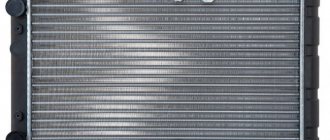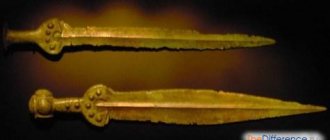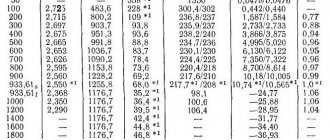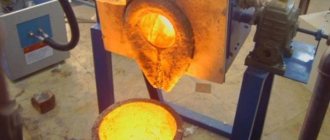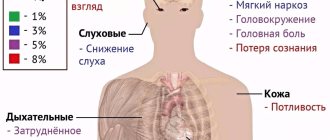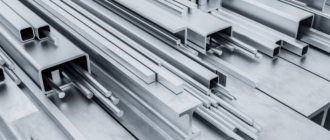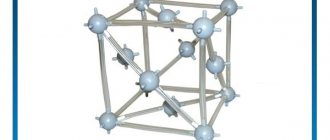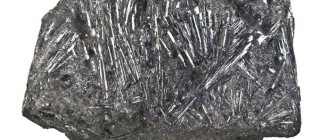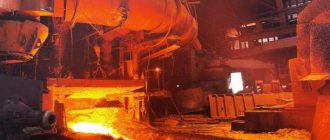The high thermal conductivity of copper and its other useful characteristics were one of the reasons for the early development of this metal by humans. To this day, copper and copper alloys are used in almost all areas of our lives.
Copper plates
Copper - briefly about thermal conductivity
Thermal conductivity is the process of transferring the energy of particles (electrons, atoms, molecules) of more heated parts of the body to particles of its less heated parts. This heat exchange leads to temperature equalization. Only energy is transferred along the body; matter does not move. A characteristic of the ability to conduct heat is the thermal conductivity coefficient, numerically equal to the amount of heat that passes through a material with an area of 1 m
2
, 1 m thick, in 1 second at a unit temperature gradient.
The thermal conductivity coefficient of copper at a temperature of 20–100 °C is 394 W/(m * K) - only silver is higher. Rolled steel is inferior to copper in this indicator by almost 9 times, and iron - by 6. Various impurities have different effects on the physical properties of metals. For copper, the rate of heat transfer decreases when substances such as:
- aluminum;
- iron;
- oxygen;
- arsenic;
- antimony;
- sulfur;
- selenium;
- phosphorus.
High thermal conductivity is characterized by the rapid spread of heating energy throughout the entire volume of the object. This ability has provided copper with widespread use in any heat transfer systems. It is used in the manufacture of tubes and radiators of refrigerators, air conditioners, vacuum units, and cars to remove excess heat from the coolant. In heating appliances, similar copper products are used for heating.
Copper's ability to conduct heat decreases when heated. The values of the thermal conductivity coefficient of copper in air depend on the temperature of the latter, which affects heat transfer (cooling). The higher the ambient temperature, the slower the metal cools and the lower its thermal conductivity. Therefore, all heat exchangers use forced airflow by a fan - this increases the efficiency of the devices and at the same time maintains thermal conductivity at an optimal level.
This is interesting: Density and specific gravity of copper - units of measurement, weight calculation
Factors influencing physical quantity
The ability to conduct heat depends on a number of factors, including the temperature, structure and electrical properties of the substance.
Material temperature
The effect of temperature on the ability to conduct heat differs for metals and nonmetals. In metals, conductivity is mainly due to free electrons. According to the Wiedemann-Franz law, the thermal conductivity of a metal is proportional to the product of the absolute temperature, expressed in Kelvin, and its electrical conductivity. In pure metals, electrical conductivity decreases with increasing temperature, so thermal conductivity remains approximately constant. In the case of alloys, electrical conductivity changes little with increasing temperature, so the thermal conductivity of alloys increases in proportion to temperature.
On the other hand, heat transfer in nonmetals is mainly associated with lattice vibrations and the exchange of lattice phonons. With the exception of high-quality crystals and low temperatures, the path of phonons in the lattice does not decrease significantly at high temperatures, and therefore the thermal conductivity remains constant over the entire temperature range, that is, it is insignificant. At temperatures below the Debye temperature, the ability of nonmetals to conduct heat, along with their heat capacity, decreases significantly.
Phase transitions and structure
When a material undergoes a first-order phase transition, for example from a solid to a liquid or from a liquid to a gas, its thermal conductivity may change. A striking example of such a change is the difference between this physical quantity for ice (2.18 W/(m*K) and water (0.90 W/(m*K).
Changes in the crystal structure of materials also affect thermal conductivity, which is explained by the anisotropic properties of various allotropic modifications of a substance of the same composition. Anisotropy affects different scattering intensities of lattice phonons, the main heat carriers in nonmetals, and in different directions in the crystal. A striking example here is sapphire, whose conductivity varies from 32 to 35 W/(m*K) depending on the direction.
Electrical conductivity
Thermal conductivity in metals changes along with electrical conductivity according to the Wiedemann-Franz law. This is due to the fact that valence electrons, moving freely throughout the crystal lattice of the metal, transfer not only electrical, but also thermal energy. For other materials, the correlation between these types of conductivity is not pronounced, due to the insignificant contribution of the electronic component to thermal conductivity (in nonmetals, lattice phonons play the main role in the mechanism of heat transfer).
Convection process
Air and other gases are, as a rule, good heat insulators in the absence of convection. This principle is the basis for the operation of many heat-insulating materials containing a large number of small voids and pores. This structure does not allow convection to spread over long distances. Examples of such man-made materials are polystyrene and silicide airgel. In nature, heat insulators such as animal skin and bird plumage work on the same principle.
Light gases such as hydrogen and gel have high thermal conductivities, while heavy gases such as argon, xenon and radon are poor conductors of heat. For example, argon, an inert gas that is heavier than air, is often used as an insulating gas filler in double-glazed windows and light bulbs. An exception is sulfur hexafluoride (SF6 gas), which is a heavy gas and has a relatively high thermal conductivity due to its high heat capacity.
What is thermal conductivity
This term means the ability of various materials to exchange energy , which in this case is represented by heat. In this case, energy transfer passes from the hotter part to the colder part and occurs due to:
- Molecules
- Atoms.
- Electrons and other particles of the metal structure.
The thermal conductivity of stainless steel will differ significantly from that of another metal - for example, the thermal conductivity of copper will be different than that of steel.
To indicate this indicator, a special value is used, called the thermal conductivity coefficient. It is characterized by the amount of heat that can pass through a material in a certain unit of time.
Indicators for steel
Thermal conductivity can vary significantly depending on the chemical composition of the metal. The coefficient of this value will be different for steel and copper. In addition, with an increase or decrease in carbon concentration, the indicator under consideration also changes.
There are other features of thermal conductivity:
- For steel that does not have impurities, the value is 70 W/(m* K).
- Carbon and high-alloy steels have much lower conductivity. Due to an increase in the concentration of impurities, it is significantly reduced.
- The thermal effect itself can also affect the structure of the metal. As a rule, after heating, the structure changes its conductivity value, which is associated with a change in the crystal lattice.
The thermal conductivity coefficient of aluminum is much higher, which is due to the lower density of this material. The thermal conductivity of brass also differs from that of steel.
The concept of thermal resistance and thermal conductivity coefficient
If thermal conductivity characterizes the ability of metals to transfer the temperature of bodies from one surface to another, then thermal resistance shows an inverse relationship, i.e. the ability of metals to prevent such transfer, in other words, to resist. Air has high thermal resistance. It is he who, most of all, prevents the transfer of heat between bodies.
The quantitative characteristic of the change in temperature of a unit area per unit of time by one degree (K) is called the thermal conductivity coefficient. The international system of units usually measures this parameter in W/m*deg. This characteristic is very important when choosing metal products that must transfer heat from one body to another.
Thermal conductivity coefficient of metals at temperature, °C
Effect of carbon concentration
The carbon concentration in steel affects the amount of heat transfer:
- Low carbon steels have a high conductivity index. That is why they are used in the manufacture of pipes, which are then used to create the heating system pipeline. The coefficient value varies from 54 to 47 W/(m* K).
- The average coefficient for common carbon steels is a value from 50 to 90 W/(m* K). That is why such material is used in the manufacture of parts for various mechanisms.
- For metals that do not contain various impurities, the coefficient is 64 W/(m* K). This value does not change significantly under thermal influence.
Thus, the considered indicator for alloyed alloys may vary depending on the operating temperature.
Density of alloys
A table of alloy density values at room temperature is presented. The following alloys are given: bronze, tin, phosphorus, duralumin, invar, constantan, brass, magnalium, manganin, monel - metal, platinum - iridium alloy, Wood's alloy, rolled and cast steel.
NOTE: Be careful! The density of the alloys in the table is indicated in powers of 10 -3. Don't forget to multiply by 1000! For example, the density of rolled steel varies from 7850 to 8000 kg/m3.
Source
Importance in everyday life and production
Why is it important to consider thermal conductivity? A similar value is indicated in various tables for each metal and is taken into account in the following cases:
In the manufacture of various heat exchangers. Heat is one of the important carriers of energy. It is used to provide comfortable living conditions in residential and other premises. When creating heating radiators and boilers, it is important to ensure rapid and complete heat transfer from the coolant to the end consumer.- In the manufacture of outlet elements. You can often encounter a situation where you need to remove heat rather than supply it. An example is the case of heat removal from the cutting edge of a tool or gear teeth. To ensure that the metal does not lose its basic performance qualities, rapid removal of thermal energy is ensured.
- When creating insulating layers. In some cases, the material should not conduct thermal energy transfer. For such operating conditions, a metal is selected that has a low heat conductivity coefficient.
The indicator under consideration is determined when testing under various conditions. As previously noted, the thermal conductivity coefficient may depend on the operating temperature. Therefore, the tables indicate several of its values.
Thermal conductivity of steel, copper, aluminum, nickel and their alloys
Ordinary iron and non-ferrous metals have different structures of molecules and atoms. This allows them to differ from each other not only in mechanical properties, but also in thermal conductivity properties, which, in turn, affects the use of certain metals in various sectors of the economy.
table 2
Steel has a thermal conductivity coefficient at an ambient temperature of 0 degrees. (C) equal to 63, and when the degree increases to 600, it decreases to 21 W/m*degree. Aluminum, under the same conditions, on the contrary, will increase the value from 202 to 422 W/m*deg. Aluminum alloys will also increase thermal conductivity as the temperature increases. Only the value of the coefficient will be an order of magnitude lower, depending on the amount of impurities, and range from 100 to 180 units.
Copper, with a temperature change within the same limits, will reduce thermal conductivity from 393 to 354 W/m*deg. At the same time, copper-containing brass alloys will have the same properties as aluminum ones, and the thermal conductivity value will vary from 100 to 200 units, depending on the amount of zinc and other impurities in the brass alloy.
The thermal conductivity coefficient of pure nickel is considered low; it will change its value from 67 to 57 W/m*deg. Alloys containing nickel will also have a coefficient with a reduced value, which, due to the content of iron and zinc, ranges from 20 to 50 W/m*deg. And the presence of chromium will reduce the thermal conductivity in metals to 12 units, with a slight increase in this value when heated.
Thermal diffusivity of metals
The table shows the values of the thermal diffusivity coefficient of pure metals depending on temperature. The thermal diffusivity of metals is indicated in the temperature range from -250 to 1600°C in the dimension m 2 /s.
The following metals are considered: aluminum, cadmium, sodium, silver, potassium, nickel, lead, cobalt, beryllium, lithium, antimony, bismuth, magnesium, zinc, tungsten, tin, antimony, iron, platinum, gold, copper, rhodium, molybdenum, tantalum, iridium.
Based on the thermal diffusivity values in the table, we can distinguish metals with the highest and lowest values of this property. A metal such as bismuth has the lowest thermal diffusivity The thermal diffusivity of pure silver is 158.3 m 2 /s at 100°C. This metal has the highest value of this characteristic.
It should be noted that as the temperature of a metal increases, its thermal diffusivity decreases, with the exception of platinum and cobalt.
Source: Industrial Ovens Reference manual for calculations and design. 2nd edition, expanded and revised, Kazantsev E.I. M., “Metallurgy”, 1975. - 368 p.
Application
The state of aggregation of materials has a distinctive structure of molecules and atoms. This is what has a great influence on metal products and their properties, depending on their purpose.
The different chemical composition of components and parts made of iron allows them to have different thermal conductivities. This is due to the structure of metals such as cast iron, steel, copper and aluminum. The porosity of cast iron products promotes slow heating, and the density of the copper structure, on the contrary, accelerates the heat transfer process. These properties are used for rapid heat removal or gradual heating of inert products. An example of using the properties of metal products is:
- kitchen utensils with various properties;
- pipe soldering equipment;
- irons;
- rolling and sliding bearings;
- plumbing equipment for heating water;
- heating devices.
Copper tubes are widely used in radiators of automobile cooling systems and air conditioners used in everyday life. Cast iron radiators retain heat in the apartment, even with an inconsistent supply of coolant at the required temperature. And radiators made of aluminum contribute to the rapid transfer of heat to the heated room.
When high temperatures occur as a result of friction of metal surfaces, it is also important to take into account the thermal conductivity of the product. In any gearbox or other mechanical equipment, the ability to remove heat will allow the mechanism parts to maintain strength and not be subject to destruction during operation. Knowledge of the heat transfer properties of various materials will allow you to competently use certain alloys of non-ferrous or ferrous metals.
More articles on the topic:
Thermal conductivity of brass and bronze
The table shows the thermal conductivity values of brass, bronze, as well as copper-nickel alloys (constantan, copel, manganin, etc.) depending on temperature - in the range from 4 to 1273 K.
The thermal conductivity of brass, bronze and other copper-based alloys increases when heated. According to the table, L96 brass has the highest thermal conductivity of the alloys considered at room temperature . Its thermal conductivity at a temperature of 300 K (27°C) is 244 W/(m deg).
Also copper alloys with high thermal conductivity include: brass LS59-1, tombac L96 and L90, tin tombac LTO90-1, rolled tombac RT-90. In addition, the thermal conductivity of brass is generally higher than that of bronze. It should be noted that bronzes with high thermal conductivity include: phosphorus, chromium and beryllium bronzes, as well as BrA5 bronze.
The copper alloy with the lowest thermal conductivity is manganese bronze - its thermal conductivity coefficient at a temperature of 27°C is 9.6 W/(m deg).
The thermal conductivity of copper alloys is always lower than the thermal conductivity of pure copper, all other things being equal.
In addition, the thermal conductivity of copper-nickel alloys is particularly low. The most thermally conductive of them at room temperature is cupronickel MNZhMts 30-0.8-1 with a thermal conductivity of 30 W/(m deg). Thermal conductivity table for brass, bronze and copper-nickel alloys
| Alloy | Temperature, K | Thermal conductivity, W/(m deg) |
| Copper-nickel alloys | ||
| Beryllium copper | 300 | 111 |
| Constantan of foreign production | 4…10…20…40…80…300 | 0,8…3,5…8,8…13…18…23 |
| Constantan MNMts40-1.5 | 273…473…573…673 | 21…26…31…37 |
| Kopel MNMts43-0.5 | 473…1273 | 25…58 |
| Manganin of foreign production | 4…10…40…80…150…300 | 0,5…2…7…13…16…22 |
| Manganin MNMts 3-12 | 273…573 | 22…36 |
| Cupronickel MNZHMts 30-0.8-1 | 300 | 30 |
| Nickel silver | 300…400…500…600…700 | 23…31…39…45…49 |
| Brass | ||
| Automatic brass UNS C36000 | 300 | 115 |
| L62 | 300…600…900 | 110…160…200 |
| L68 deformed brass | 80…150…300…900 | 71…84…110…120 |
| L80 semi-tompak | 300…600…900 | 110…120…140 |
| L90 | 273…373…473…573…673…773…873 | 114…126…142…157…175…188…203 |
| L96 tombak drawn | 300…400…500…600…700…800 | 244…245…246…250…255…260 |
| LAN59-3-2 aluminum-nickel brass | 300…600…900 | 84…120…150 |
| LMC58-2 manganese brass | 300…600…900 | 70…100…120 |
| LO62-1 tin | 300 | 99 |
| LO70-1 tin | 300…600 | 92…140 |
| LS59-1 annealed brass | 4…10…20…40…80…300 | 3,4…10…19…34…54…120 |
| LS59-1V leaded brass | 300…600…900 | 110…140…180 |
| LTO90-1 tombak tin | 300…400…500…600…700…800…900 | 124…141…157…174…194…209…222 |
| Bronze | ||
| BrA5 | 300…400…500…600…700…800…900 | 105…114…124…133…141…148…153 |
| BrA7 | 300…400…500…600…700…800…900 | 97…105…114…122…129…135…141 |
| BrAZhMC10-3-1.5 | 300…600…800 | 59…77…84 |
| BrAZHN10-4-4 | 300…400…500 | 75…87…97 |
| BrAZHN11-6-6 | 300…400…500…600…700…800 | 64…71…77…82…87…94 |
| BrB2, annealed at 573K | 4…10…20…40…80 | 2,3…5…11…21…37 |
| BrKd | 293 | 340 |
| BrKMTs3-1 | 300…400…500…600…700 | 42…50…55…54…54 |
| BrMC-5 | 300…400…500…600…700 | 94…103…112…122…127 |
| BrMTsS8-20 | 300…400…500…600…700…800…900 | 32…37…43…46…49…51…53 |
| BrO10 | 300…400…500 | 48…52…56 |
| BrOS10-10 | 300…400…600…800 | 45…51…61…67 |
| BrOS5-25 | 300…400…500…600…700…800…900 | 58…64…71…77…80…83…85 |
| BrOF10-1 | 300…400…500…600…700…800…900 | 34…38…43…46…49…51…52 |
| BrOTs10-2 | 300…400…500…600…700…800…900 | 55…56…63…68…72…75…77 |
| BrOTs4-3 | 300…400…500…600…700…800…900 | 84…93…101…108…114…120…124 |
| BrOTs6-6-3 | 300…400…500…600…700…800…900 | 64…71…77…82…87…91…93 |
| BrOTs8-4 | 300…400…500…600…700…800…900 | 68…77…83…88…93…96…100 |
| Aluminum bronze | 300 | 56 |
| Aged beryllium bronze | 20…80…150…300 | 18…65…110…170 |
| Manganese bronze | 300 | 9,6 |
| Production leaded bronze | 300 | 26 |
| Phosphor bronze 10% | 300 | 50 |
| Phosphor bronze annealed | 20…80…150…300 | 6…20…77…190 |
| Chromium bronze UNS C18200 | 300 | 171 |
Note: Temperatures in the table are given in degrees Kelvin !
Properties of copper Cu: thermal conductivity and density of copper
The table shows the thermophysical properties of copper depending on temperature in the range from 50 to 1600 degrees Kelvin.
The density of copper is 8933 kg/m3 (or 8.93 g/cm3) at room temperature . Copper is almost four times heavier than aluminum and iron. These metals will float on the surface of the liquid copper. The copper density values in the table are indicated in kg/m3.
The dependence of copper density on its temperature is presented in the table. It should be noted that the density of copper decreases when it is heated, both as a solid metal and as a liquid copper. The decrease in the density of this metal is due to its expansion when heated - the volume of copper increases. It should be noted that liquid copper has a density of about 8000 kg/m3 at temperatures up to 1300°C.
The thermal conductivity of copper is 401 W/(m deg) at room temperature, which is a fairly high value among metals, comparable to the thermal conductivity of silver.
At 1357K (1084°C) copper goes into a liquid state, which is reflected in the table by a sharp drop in the value of the thermal conductivity coefficient of copper. It can be seen that the thermal conductivity of liquid copper is almost two times lower than that of solid metal.
The thermal conductivity of copper tends to decrease when it is heated, but at temperatures above 1400 K, the thermal conductivity value begins to increase again.
The table discusses the following thermophysical properties of copper at various temperatures:
- copper density, kg/m3;
- specific heat capacity, J/(kg deg);
- thermal diffusivity, m2/s;
- thermal conductivity of copper, W/(m K);
- electrical resistivity, Ohm m;
- Lorentz function;
- heat capacity ratio.
What does thermal conductivity depend on?
Thermal conductivity is a physical quantity and largely depends on the parameters of temperature, pressure and type of substance. Most of the coefficients are determined empirically. Many methods have been developed for this. The results are compiled into reference tables, which are then used in various scientific and engineering calculations. Bodies have different temperatures and during heat exchange it (temperature) will be distributed unevenly. In other words, you need to know how the thermal conductivity coefficient depends on temperature.
Numerous experiments show that for many materials the relationship between the coefficient and the thermal conductivity itself is linear.
Coefficient of thermal conductivity
The thermal conductivity of metals is determined by the shape of its crystal lattice.
In many ways, the thermal conductivity coefficient depends on the structure of the material, the size of its pores and humidity.
When is the thermal conductivity coefficient taken into account?
Thermal conductivity parameters must be taken into account when choosing materials for enclosing structures - walls, ceilings, etc. In rooms where the walls are made of materials with high thermal conductivity, it will be quite cool in the cold season. Decorating the room won't help either. In order to avoid this, the walls must be made quite thick. This will certainly lead to increased costs for materials and labor.
Insulation scheme for a wooden house
That is why the construction of the walls requires the use of materials with low thermal conductivity (mineral wool, polystyrene foam, etc.).
Indicators for steel
- In reference materials on the thermal conductivity of various materials, a special place is occupied by the data presented on steels of different grades. Thus, the reference materials contain experimental and calculated data for the following types of steel alloys: resistant to corrosion and elevated temperatures;
- intended for the production of springs and cutting tools;
- saturated with alloying additives.
The tables summarize the indicators that were collected for steels in the temperature range from -263 to 1200 degrees. The average indicators are for:
- carbon steels 50 – 90 W/(m×deg);
- corrosion-resistant, heat- and heat-resistant alloys classified as martensitic - from 30 to 45 W/(m×deg);
- alloys classified as austenitic from 12 to 22 W/(m×deg).
These reference materials contain information about the properties of cast iron.
Thermal conductivity of non-ferrous metals and technical alloys
The table shows the thermal conductivity values of metals (non-ferrous), as well as the chemical composition of metals and technical alloys in the temperature range from 0 to 600°C.
Non-ferrous metals and alloys: nickel Ni, monel, nichrome; nickel alloys (according to GOST 492-58): cupronickel NM81, NM70, constantan NMMts 58.5-1.54, copel NM 56.5, monel NMZhMts and K-monel, alumel, chromel, manganin NMMts 85-12, invar; magnesium alloys (according to GOST 2856-68), electron, platinum-rhodium; soft solders (according to GOST 1499-70): pure tin, lead, POS-90, POS-40, POS-30, Rose alloy, Wood alloy.
Thermal conductivity coefficients of aluminum, copper and nickel alloys
When carrying out calculations related to non-ferrous metals and alloys, designers use reference materials located in special tables.
Table of thermal conductivity of aluminum alloys
They present materials on the thermal conductivity of non-ferrous metals and alloys; in addition to these data, information is provided on the chemical composition of the alloys. The studies were carried out at temperatures from 0 to 600 °C.
According to the information collected in these tabular materials, it is clear that non-ferrous metals with high thermal conductivity include alloys based on magnesium and nickel. Metals with low thermal conductivity include nichrome, invar and some others.
Most metals have good thermal conductivity, some have more, others less. Metals with good thermal conductivity include gold, copper and some others. Materials with low thermal conductivity include tin, aluminum, etc.
Table of thermal conductivity of nickel alloys
High thermal conductivity can be both an advantage and a disadvantage. It all depends on the scope of application. For example, high thermal conductivity is good for kitchenware. Materials with low thermal conductivity are used to create permanent connections of metal parts. There are entire families of tin-based alloys.
Impurities in copper alloys
from here
Impurities contained in copper (and, naturally, interacting with it) are divided into three groups.
Forming solid solutions with copper
Such impurities include aluminum, antimony, nickel, iron, tin, zinc, etc. These additives significantly reduce electrical and thermal conductivity . The grades that are primarily used for the production of conductive elements include M0 and M1. If the copper alloy contains antimony, its hot pressure treatment becomes significantly more difficult.
Impurities that do not dissolve in copper
These include lead, bismuth, etc. Although they do not affect the electrical conductivity of the base metal, such impurities make it difficult to process by pressure.
Melting point of brass
The melting point of brass of the considered brands varies in the range from 865 to 1055 °C. The most fusible is manganese brass LMts58-2 with a melting point of 865°C. Low-melting brasses also include: L59, L62, LAN59-3-2, LKS65-1.5-3 and others.
L96 brass has the highest melting point (1055°C).
Among the refractory brasses, according to the table, we can also distinguish: brass L90, LA85-0.5, tin tombak LTO90-1. Melting point of brass
| Brass | t, °С | Brass | t, °С |
| L59 | 885 | LMts55-3-1 | 930 |
| L62 | 898 | LMts58-2 manganese brass | 865 |
| L63 | 900 | LMtsA57-3-1 | 920 |
| L66 | 905 | LMtsZh52-4-1 | 940 |
| L68 deformed brass | 909 | LMtsOS58-2-2-2 | 900 |
| L70 | 915 | LMtsS58-2-2 | 900 |
| L75 | 980 | LN56-3 | 890 |
| L80 semi-tompak | 965 | LN65-5 | 960 |
| L85 | 990 | LO59-1 | 885 |
| L90 | 1025 | LO60-1 | 885 |
| L96 tombak drawn | 1055 | LO62-1 tin | 885 |
| LA67-2.5 | 995 | LO65-1-2 | 920 |
| LA77-2 | 930 | LO70-1 tin | 890 |
| LA85-0.5 | 1020 | LO74-3 | 885 |
| LAZ60-1-1 | 904 | LO90-1 | 995 |
| LAZHMts66-6-3-2 | 899 | LS59-1 | 900 |
| LAN59-3-2 aluminum-nickel brass | 892 | LS59-1V leaded brass | 900 |
| LANKMts75-2-2.5-0.5-0.5 | 940 | LS60-1 | 900 |
| LZhMts59-1-1 | 885 | LS63-3 | 885 |
| LK80-3 | 900 | LS64-2 | 910 |
| LKS65-1.5-3 | 870 | LS74-3 | 965 |
| LKS80-3-3 | 900 | LTO90-1 tombak tin | 1015 |
Melting point of bronze
The melting point of bronze ranges from 854 to 1135°C. Bronze AZHN11-6-6 has the highest melting point - it melts at a temperature of 1408 K (1135°C). The melting point of this bronze is even higher than the melting point of copper, which is 1084.6°C.
Bronzes with a low melting point include: BrOTs8-4, BrB2, BrMTsS8-20, BrSN60-2.5 and the like.
Melting point of bronze
| Bronze | t, °С | Bronze | t, °С |
| BrA5 | 1056 | BrOS8-12 | 940 |
| BrA7 | 1040 | BrOSN10-2-3 | 1000 |
| BrA10 | 1040 | BrOF10-1 | 934 |
| BrAZH9-4 | 1040 | BrOF4-0.25 | 1060 |
| BrAZhMC10-3-1.5 | 1045 | BrOTs10-2 | 1015 |
| BrAZHN10-4-4 | 1084 | BrOTs4-3 | 1045 |
| BrAZHN11-6-6 | 1135 | BrOTs6-6-3 | 967 |
| BrAZhS7-1.5-1.5 | 1020 | BrOTs8-4 | 854 |
| BrAMTS9-2 | 1060 | BrOTsS3.5-6-5 | 980 |
| BrB2 | 864 | BrOTsS4-4-17 | 920 |
| BrB2.5 | 930 | BrOTsS4-4-2.5 | 887 |
| BrKMTs3-1 | 970 | BrOTsS5-5-5 | 955 |
| BrKN1-3 | 1050 | BrOTsS8-4-3 | 1015 |
| BrKS3-4 | 1020 | BrOTsS3-12-5 | 1000 |
| BrKTs4-4 | 1000 | BrOTsSN3-7-5-1 | 990 |
| BrMG0.3 | 1076 | BrS30 | 975 |
| BrMC5 | 1007 | BrSN60-2.5 | 885 |
| BrMTsS8-20 | 885 | BrSUN7-2 | 950 |
| BrO10 | 1020 | BrХ0.5 | 1073 |
| BrOS10-10 | 925 | BrTsr0.4 | 965 |
| BrOS10-5 | 980 | Cadmium | 1040 |
| BrOS12-7 | 930 | Silver | 1082 |
| BrOS5-25 | 899 | HOT alloy | 1075 |
Note: The melting and boiling points of other common metals are given in this table.
- Physical quantities. Directory. Ed. I.S. Grigorieva, E.Z. Meilikhova. - M.: Energoatomizdat, 1991. - 1232 p.
- Chirkin V.S. Thermophysical properties of nuclear technology materials. M.: Atomizdat, 1967 - 474 p.
Methods for studying thermal conductivity parameters
When studying thermal conductivity parameters, one must remember that the characteristics of a particular metal or its alloys depend on the method of its production. For example, the parameters of a metal produced by casting may differ significantly from the characteristics of a material manufactured using powder metallurgy methods. The properties of raw metal are fundamentally different from those that have undergone heat treatment.
Thermal instability, that is, the transformation of individual properties of the metal after exposure to high temperatures, is common to almost all materials. As an example, metals after prolonged exposure to different temperatures are able to achieve different levels of recrystallization, and this is reflected in the parameters of thermal conductivity.
Steel structure after heat treatment
We can say the following: when conducting studies of thermal conductivity parameters, it is necessary to use samples of metals and their alloys in a standard and specific technological state, for example, after heat treatment.
For example, there are requirements for grinding metal to conduct research using thermal analysis methods. Indeed, such a requirement exists in a number of studies. There are also such requirements - such as the production of special plates and many others.
The non-thermal stability of metals poses a number of limitations on the use of thermophysical research methods. The fact is that this method of conducting research requires heating the samples at least twice, in a certain temperature range.
One of the methods is called relaxation-dynamic. It is designed to perform mass measurements of heat capacity of metals. In this method, the transition curve of the sample temperature between its two stationary states is recorded. This process is a consequence of a jump in thermal power introduced into the test sample.
This method can be called relative. It uses test and comparison samples. The main thing is that the samples have the same emitting surface. When conducting research, the temperature affecting the samples must change in steps, and upon reaching the specified parameters, it is necessary to maintain a certain amount of time. The direction of temperature change and its step must be selected in such a way that the sample intended for testing is heated evenly.
At these moments, the heat flows will be equal and the heat transfer ratio will be determined as the difference in the rates of temperature fluctuations. Sometimes during these studies, the source of indirect heating of the test and comparative sample. Additional thermal loads may be created on one of the samples in comparison with the second sample.
Necessity of calculations
Assessing the effectiveness of thermal insulation
Different climatic regions of Russia have different temperature conditions, so each of them has its own standard indicators of heat transfer resistance. These calculations are carried out for all elements of the structure in contact with the external environment. If the structural resistance is within normal limits, then you don’t have to worry about insulation.
If thermal insulation of the structure is not provided, then you need to make the right choice of insulating material with suitable thermal characteristics.
Heat loss
Heat losses at home
An equally important task is to predict heat losses, without which it is impossible to properly plan a heating system and create ideal thermal insulation. Such calculations may be necessary when choosing the optimal boiler model, the number of radiators required and their correct placement.
To determine heat losses through any structure, you need to know the resistance, which is calculated using the temperature difference and the amount of heat lost from one square meter of the enclosing structure. And so, if we know the area of the structure and its thermal resistance, and also know for what climatic conditions the calculation is being made, then we can accurately determine the heat losses. There is a good calculator for calculating heat loss at home (it can even calculate how much money will be spent on heating, approximately of course).
Such calculations in a building are carried out for all building envelopes interacting with cold air flows, and then summed up to determine the total heat loss. Based on the obtained value, a heating system is designed that should fully compensate for these losses. If the heat losses are too large, they entail additional financial costs, and not everyone can afford this. In this situation, you need to think about improving the thermal insulation system.
Separately, we need to talk about windows, for which the heat transfer resistance is determined by regulatory documents. There is no need to do the calculations yourself. There are ready-made tables in which resistance values are entered for all types of window and balcony door structures. Thermal losses of windows are calculated based on the area, as well as the temperature difference on different sides of the structure.
The calculations above are suitable for beginners who are taking their first steps in designing energy-efficient homes. If a professional gets down to business, then his calculations are more complex, since many correction factors are additionally taken into account - for insolation, light absorption, reflection of sunlight, heterogeneity of structures and others.
Which thermal conductivity measurement method is best for your material?
There are methods for measuring thermal conductivity such as LFA, GHP, HFM and TCT. They differ from each other in the sizes and geometric parameters of the samples used to test the thermal conductivity of metals.
These abbreviations can be deciphered as:
- GHP (hot guard zone method);
- HFM (heat flow method);
- TCT (hot wire method).
The above methods are used to determine the coefficients of various metals and their alloys. At the same time, using these methods, they study other materials, for example, mineral ceramics or refractory materials.
The metal samples on which the research is carried out have overall dimensions of 12.7 × 12.7 × 2.
A little about thermal conductivity
In physics, thermal conductivity is understood as the movement of energy in an object from more heated small particles to less heated ones. Thanks to this process, the temperature of the object in question as a whole is equalized. The magnitude of the ability to conduct heat is characterized by the thermal conductivity coefficient. This parameter is equal to the amount of heat that a material 1 meter thick passes through a surface area of 1 m2 for one second at a unit temperature difference.
| Material | Thermal conductivity coefficient, W/(m*K) |
| Silver | 428 |
| Copper | 394 |
| Aluminum | 220 |
| Iron | 74 |
| Steel | 45 |
| Lead | 35 |
| Brick | 0,77 |
Copper has a thermal conductivity coefficient of 394 W/(m*K) at temperatures from 20 to 100 °C. Only silver can compete with it. And for steel and iron this figure is 9 and 6 times lower, respectively (see table). It is worth noting that the thermal conductivity of products made from copper largely depends on impurities (however, this also applies to other metals). For example, the rate of heat conduction decreases if substances such as:
- iron;
- arsenic;
- oxygen;
- selenium;
- aluminum;
- antimony;
- phosphorus;
- sulfur.
Copper wire
If you add zinc to copper, you get brass, which has a much lower thermal conductivity coefficient. At the same time, adding other substances to copper can significantly reduce the cost of finished products and give them characteristics such as strength and wear resistance. For example, brass is characterized by higher technological, mechanical and anti-friction properties.
Since high thermal conductivity is characterized by rapid distribution of heating energy throughout the entire object, copper is widely used in heat exchange systems. At the moment, radiators and tubes for refrigerators, vacuum units and cars are made from it for rapid heat removal. Copper elements are also used in heating installations, but for heating.
Copper heating radiator
In order to maintain the thermal conductivity of the metal at a high level (and therefore make the operation of copper devices as efficient as possible), forced airflow by fans is used in all heat exchange systems. This decision is due to the fact that as the temperature of the environment increases, the thermal conductivity of any material decreases significantly, because heat transfer slows down.
Thermal conductivity of aluminum and copper - which metal is better?
The thermal conductivity of aluminum and copper is different - for the first it is 1.5 times less than for the second. For aluminum, this parameter is 202–236 W/(m * K) and is quite high compared to other metals, but lower than that of gold, copper, and silver. The scope of application of aluminum and copper, where high thermal conductivity is required, depends on a number of other properties of these materials.
Aluminum is not inferior to copper in anti-corrosion properties and is superior in the following indicators:
- the density (specific gravity) of aluminum is 3 times less;
- the cost is 3.5 times lower.
A similar product, but made of aluminum, is much lighter than copper. Since the weight of metal required is 3 times less, and its price is 3.5 times lower, an aluminum part can be about 10 times cheaper. Thanks to this and its high thermal conductivity, aluminum is widely used in the production of tableware and food foil for ovens. Since this metal is soft, it is not used in its pure form - its alloys are mainly common (the most famous is duralumin).
In various heat exchangers, the main thing is the rate of release of excess energy into the environment. This problem is solved by intensively blowing the radiator using a fan. At the same time, the lower thermal conductivity of aluminum practically does not affect the quality of cooling, and equipment and devices are much lighter and cheaper (for example, computers and household appliances). Recently, there has been a tendency in production to replace copper tubes in air conditioning systems with aluminum ones.
Copper is practically irreplaceable in the radio industry and electronics as a conductive material. Due to its high ductility, it can be used to draw wire with a diameter of up to 0.005 mm and to make other very thin conductive connections used for electronic devices. Higher conductivity than aluminum ensures minimal losses and less heating of radio elements. Thermal conductivity allows you to effectively remove the heat generated during operation to the external elements of devices - housing, supply contacts (for example, microcircuits, modern microprocessors).
Copper templates are used in welding when it is necessary to deposit the desired shape on a steel part. High thermal conductivity will not allow the copper template to connect to the welded metal. Aluminum cannot be used in such cases, since there is a high probability of it melting or burning. Copper is also used in carbon arc welding - a rod made of this material serves as a non-consumable cathode.
Which conducts heat better: aluminum or copper?
Today, radiators are made from a variety of materials, the most common being steel, stainless steel and aluminum.
Always have doubts about which radiator to choose for installation in your home? Obviously, this depends on personal taste, as well as on the requirements that you have set for yourself regarding the quality of the heating of the room.
Aluminum is by far the most environmentally friendly material and has a huge number of advantages.
Differences between copper and aluminum
The main concerns regarding winding material selection reflect five characteristic differences between copper and aluminum:
Table : Five characteristic differences between copper and aluminum
| Parameter | Aluminum | Copper |
| Expansion coefficient per °C x 10 -6 at 20 °C | 23 | 16,6 |
| Thermal Conductivity BTU/ft/h/FFT 2/°F at 20°C | 126 | 222 |
| Electrical conductivity % at 20°C | 61 | 101 |
| Tensile strength n/mm 2 (soft) | 28-42 | 40 |
How to choose a heating radiator: expert advice
In this article we will not consider cast iron radiators, because... they are losing popularity among buyers.
Let's focus on the most popular models.
The material will tell you in detail about the advantages of aluminum and steel batteries.
Aluminum radiators are lightweight
Aluminum radiators are lighter than traditional steel or cast iron radiators, this fact makes it possible to place such a radiator on any wall in the room.
Aluminum batteries can be hung on the wall, even in situations where the thickness does not allow for deep fastening.
This significantly saves the cost of paying for construction work, since they can be hung very quickly and reliably.
Aluminum is a corrosion resistant material
Aluminum is not subject to corrosion, which makes it an ideal material for the production of radiators that are intended to be installed in areas such as bathrooms and kitchens where there is high humidity.
Aluminum conducts heat well
Aluminum heats up quickly, making it an excellent heat conductor.
Aluminum radiators have a low water content, which means that once turned on, such devices give an intense burst of heat and heat up rooms quite quickly.
By installing aluminum radiators, you can quickly achieve the required temperature in the rooms, as they have the shortest response time.
The main advantage is a significant saving in energy costs during the heating season and, as a wonderful bonus, saving money, since aluminum radiators can be turned off while you are away from the house, and when you return home, turn them on and quickly get a warm home without spending a long time waiting.
Aluminum radiators come in a wide range of designs and colors
There is a common belief that efficient heat cannot be beautiful and original. Fortunately, the days when design must give way to superior performance are over.
Aluminum radiators have a diverse range of designs and offer even the most demanding buyer a decent choice.
You can choose your own finishing color that will perfectly match the style of your home, the shape of the radiator will be one hundred percent in harmony with your home or office atmosphere.
Stainless steel
The use of steel for the production of heat exchangers allows us to obtain durable products, which are mainly used for individual heating systems in houses and cottages.
Due to the ability to control the quality of the coolant and the pressure in the system, steel appliances will be an excellent choice for autonomous heating systems.
Provided that high-quality coolant is supplied and the working fluid pressure is moderate, such devices will last more than 30 years.
Connectivity
Oxides, chlorides, sulfides or base metals that are more conductive on copper than on aluminum. This fact makes cleaning and protecting aluminum connectors more important. Some consider copper and aluminum compounds to be incompatible. Also questionable is the mating of connections between the aluminum of the transformers and the copper connection wire.
Expansion coefficient
When temperature changes, aluminum expands almost a third more than copper. This expansion, along with the ductile nature of aluminum, causes some problems for improperly installed bolted connections.
To avoid loosening of the connection, it must be spring-loaded. By using either cup washers or pressure washers, the necessary elasticity during articulation can be achieved without compressing the aluminum.
When using proper fittings, aluminum connections can be equal in quality to copper ones.
Thermal conductivity
Some argue that since the thermal conductivity of copper is higher than aluminum, this has the effect of reducing the hot spot temperature of the transformer winding.
This is only true when the copper and aluminum winding conductors are of the same size, geometry and design.
Therefore, for any power transformer of a given size, the thermal conductivity characteristics of aluminum can be very similar to copper.
Disadvantages of the high thermal conductivity of copper and its alloys
Copper has a much higher cost than brass or aluminum. At the same time, this metal has its disadvantages, which are directly related to its advantages. High thermal conductivity leads to the need to create special conditions during cutting, welding and soldering of copper elements. Since copper elements need to be heated much more concentrated compared to steel. Also, preliminary and concomitant heating of the part is often required.
Don’t forget that copper pipes require careful insulation if they make up the main line or distribution of the heating system. Which leads to an increase in the cost of network installation compared to options when other materials are used.
Example of thermal insulation of copper pipes
Difficulties also arise with gas welding of copper: this process will require more powerful torches. When welding metal 8–10 mm thick, two or three torches will be required. While one torch is used for welding, the other is heating the part. In general, welding work with copper requires increased costs for consumables.
It should also be said about the need to use special tools. So, to cut brass and bronze up to 15 cm thick, you will need a cutter capable of working with high-chromium steel 30 cm thick. Moreover, the same tool is enough to work with pure copper only 5 cm thick.
Plasma cutting of copper
Is it possible to increase the thermal conductivity of copper?
Copper is widely used in the creation of microcircuits for electronic devices and is designed to remove heat from parts heated by electric current. When trying to increase the speed of modern computers, developers were faced with the problem of cooling processors and other parts. One of the solutions was to split the processor into several cores. However, this method of combating overheating has exhausted itself, and now it is necessary to look for new conductors with higher thermal and electrical conductivity.
One solution to this problem is the recently discovered element graphene. Thanks to graphene deposition, the thermal conductivity of the copper element increases by 25%. However, the invention is still at the development level.
